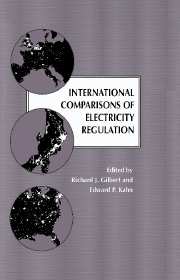Book contents
- Frontmatter
- Contents
- Preface
- International Comparisons of Electricity Regulation
- 1 Introduction: International comparisons of electricity regulation
- 2 Regulation, public ownership and privatisation of the English electricity industry
- 3 How should it be done? Electricity regulation in Argentina, Brazil, Uruguay, and Chile
- 4 From club-regulation to market competition in the Scandinavian electricity supply industry
- 5 Competition and institutional change in U.S. electric power regulation
- 6 The Japanese electric utility industry
- 7 Regulation of the market for electricity in the Federal Republic of Germany
- 8 The evolution of New Zealand's electricity supply structure
- 9 Regulation of electric power in Canada
- 10 The French electricity industry
- 11 The Yugoslav electric power industry
- Index
9 - Regulation of electric power in Canada
Published online by Cambridge University Press: 21 March 2010
- Frontmatter
- Contents
- Preface
- International Comparisons of Electricity Regulation
- 1 Introduction: International comparisons of electricity regulation
- 2 Regulation, public ownership and privatisation of the English electricity industry
- 3 How should it be done? Electricity regulation in Argentina, Brazil, Uruguay, and Chile
- 4 From club-regulation to market competition in the Scandinavian electricity supply industry
- 5 Competition and institutional change in U.S. electric power regulation
- 6 The Japanese electric utility industry
- 7 Regulation of the market for electricity in the Federal Republic of Germany
- 8 The evolution of New Zealand's electricity supply structure
- 9 Regulation of electric power in Canada
- 10 The French electricity industry
- 11 The Yugoslav electric power industry
- Index
Summary
Introduction
The electricity grid in Canada is composed of generation facilities owned by 11 major companies organized primarily along provincial lines. Tables 9–1 and 9–2 provide data by province for 1993-94 on capacity and generation of energy by primary energy source.
The sources of power vary greatly across the provinces. In 1993, hydro generation represented 62% of electrical energy generated in Canada, hydro being near 100% in Quebec, Newfoundland, Manitoba, and British Columbia, 28% in Ontario, and less than 4% in Alberta. Nuclear facilities provided 17% of Canadian total electricity generated in 1993 but exist in only three provinces – New Brunswick and Quebec (35% and 3% respectively) and Ontario (52%). The choice of the nuclear option in Ontario is examined later. Conventional thermal generation represented 21% of Canadian sources.
The growth of electricity demand has over the years been highly correlated with the growth in gross domestic product, the two tracking each other fairly closely over the course of business cycles. Canadians are very intensive users of energy in general and electricity in particular. Climate and geography have been important contributing factors as has been the historically low price of electricity. The latter is not only a result of the availability of major hydraulic resources but also because public utilities, which dominate in Canada, do not pay corporate income taxes and are able to borrow at favourable rates. The real average price of electricity, which was 4.25 1991 Canadian ¢/kWh in 1970, increased during the mid-1970s as new facilities came on line, particularly nuclear facilities in Ontario.
- Type
- Chapter
- Information
- International Comparisons of Electricity Regulation , pp. 366 - 405Publisher: Cambridge University PressPrint publication year: 1996
- 1
- Cited by



